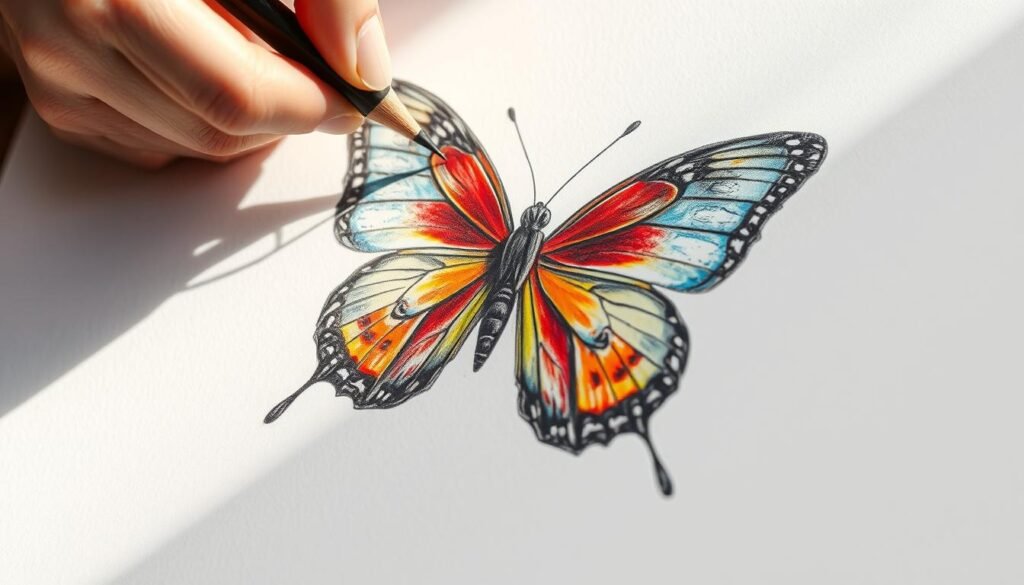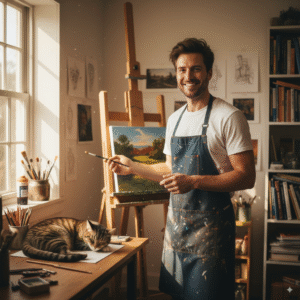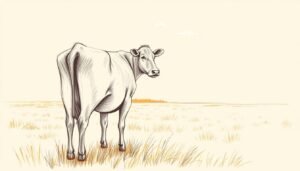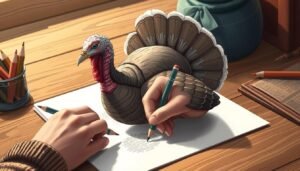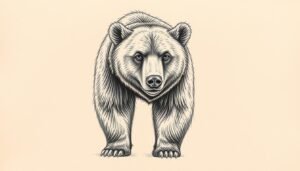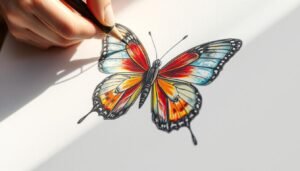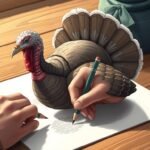Drawing butterflies is a fun and rewarding activity. It lets artists show off the detailed patterns and bright colors of these lovely creatures. I remember being amazed by the butterflies‘ delicate designs and graceful flight.
In this article, I’ll show you how to draw a beautiful butterfly. We’ll cover the techniques and skills needed to make these amazing creatures come alive on paper.
Key Takeaways
- Understand the basic shapes and structures of butterflies
- Learn techniques for capturing delicate patterns and colors
- Discover tips for creating a realistic and visually appealing drawing
- Explore different materials and tools for drawing butterflies
Essential Supplies for Drawing a Butterfly
Before you start drawing, make sure you have the right tools. Drawing a butterfly needs the right tools and materials for the best results.You can learn more about how-to-draw-a-person.
Recommended Pencils and Paper Types
You’ll need high-quality pencils for drawing a butterfly. Soft (B) pencils are great for shading, while hard (H) pencils work well for fine details. Start with HB, 2B, and 4B pencils.
For paper, pick a type that’s good for drawing. Look for “heavyweight” or “mixed media” paper. It can handle different drawing techniques and media. A smooth finish is best for detailed work, while a textured finish can add interesting effects.
Other Useful Tools and Materials
There are other tools that can help with your butterfly drawing. A good eraser is key for fixing mistakes and adding highlights. A sharpener keeps your pencils sharp, and a blending stump smooths out shading.
Colored pencils or markers can add bright colors to your drawing. Use a variety of colors to show the detailed wings of a butterfly. You can also try pastels or watercolors for unique effects.You can learn more about how-to-draw-stitch.
Understanding Butterfly Anatomy
Exploring a butterfly’s anatomy shows its detailed structure. To draw a butterfly well, knowing its parts is key.
Wing Structure and Patterns
A butterfly’s wings stand out the most. They have two main parts: the forewing and the hindwing. The forewing is bigger and more colorful. The hindwing is smaller and often less bright.
The wings are covered in tiny scales. These scales create the wings’ colors and texture.
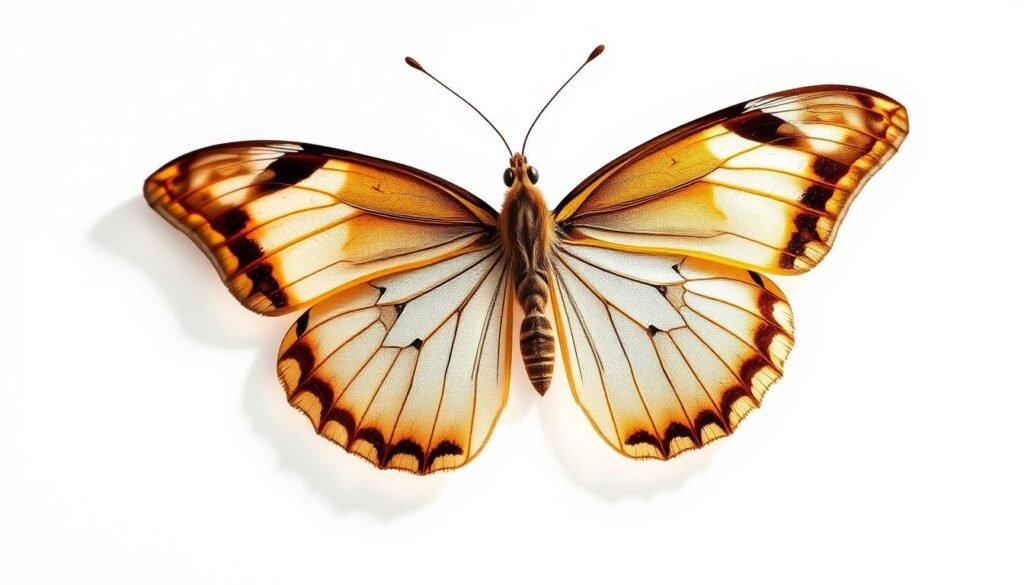
The patterns on a butterfly’s wings come from the scales’ arrangement. For instance, the monarch butterfly has orange and black wings with white spots. The swallowtail has shiny blue and black wings. Knowing these patterns helps make a drawing look real. For tips on drawing, check out this resource.
Body Parts and Proportions
A butterfly’s body has three main parts: the head, thorax, and abdomen. The head has the eyes and antennae. The thorax connects the wings to the body. The abdomen is at the back and has the digestive organs.
To draw a butterfly right, knowing its body parts’ sizes is important. The thorax is the biggest, followed by the abdomen. The head is the smallest.
- The head is connected to the thorax by a thin neck.
- The thorax is the strongest part of the butterfly’s body.
- The abdomen is usually slightly rounded.
Step-by-Step Guide to Drawing Butterflies
Now, let’s dive into the fun part of drawing beautiful butterflies. Knowing about butterfly anatomy and having the right tools is key. This way, we can make amazing art.You can learn more about how-to-draw-eyes.
Drawing the Basic Shape
To draw a butterfly, start with the basic shape. Sketch a small oval for the body and a bigger oval for the wings. The wings should be about twice as big as the body. Use a reference guide to get the size right.
Adding Details to the Wings
After the basic shape, add details to the wings. Look at the patterns and shapes in the wings and draw them in your picture. Use soft, flowing lines for a natural look. You can also add scales and veins for a more realistic butterfly.
Finalizing the Body and Antennae
Next, work on the body and antennae. The body should be long and thin, with thin, slightly clubbed antennae. Use a fine pencil for these details, making sure they match the rest of the butterfly.
By following these steps, you can make a stunning butterfly drawing. Remember, the more you practice, the better you’ll get. So, don’t worry if your first drawings aren’t perfect.
Different Butterfly Species to Draw
The world of butterflies is vast, with many species to discover and draw. As you explore butterfly drawing, you’ll find a wide range of species. Each has its own unique characteristics and features.
Common Types: Monarch and Swallowtail
The Monarch and Swallowtail are among the most common butterflies. The Monarch is known for its orange and black wings. The Swallowtail is recognized by its striking tail extensions.
To draw these species, focus on their wing patterns and colors. For example, when drawing a Monarch, pay attention to the veins and how light interacts with the scales. You can find more tips and tutorials on drawing butterflies on ClauCreates.
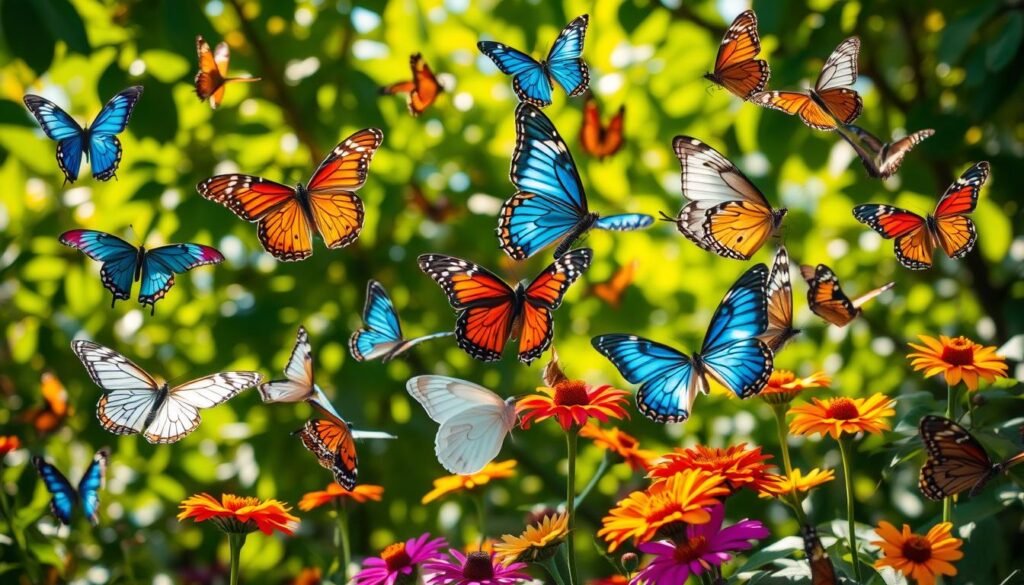
Exotic Varieties: Blue Morpho and Zebra
If you’re interested in drawing exotic butterflies, consider the Blue Morpho and Zebra. The Blue Morpho has iridescent blue wings that seem to change color in the light. The Zebra butterfly has striking black and white stripes, perfect for practicing shading.
When drawing these exotic varieties, focus on their unique color patterns and textures. Try different shading techniques to achieve a realistic effect. Don’t be afraid to experiment with new colors and combinations.
Tips for Capturing Realistic Colors
To make your butterfly drawing come alive, focus on realistic colors. Colors are key to making your artwork look good and real.
Choosing the Right Color Palette
First, pick the right colors. Observe the butterfly species you want to draw. Note the colors on its wings and body. Look at photos or see real butterflies for color ideas.
- Find the main colors on the butterfly’s wings and body.
- Think about color variations and shades for depth.
- Try different color mixes for a realistic look.
Blending Techniques for Beautiful Wings
Blending is key for smooth color transitions on the butterfly’s wings. Layering colors gently makes them look real and three-dimensional.
- Begin with a base color and add shading and highlights.
- Use a blending stump or soft brush for smooth color merging.
- Practice blending to get a natural, gradient look.
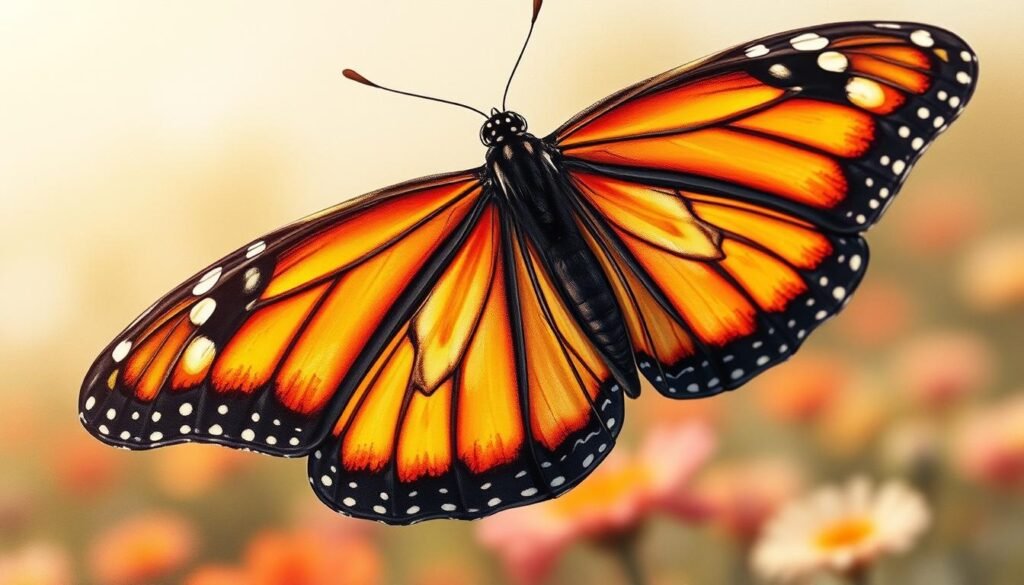
Follow these tips and keep practicing. You’ll get better at realistic colors in your butterfly drawings.
Drawing Butterflies in Flight
Learning to draw butterflies in flight is all about showing their movement and freedom. It’s key to know how butterflies’ wings work and move.
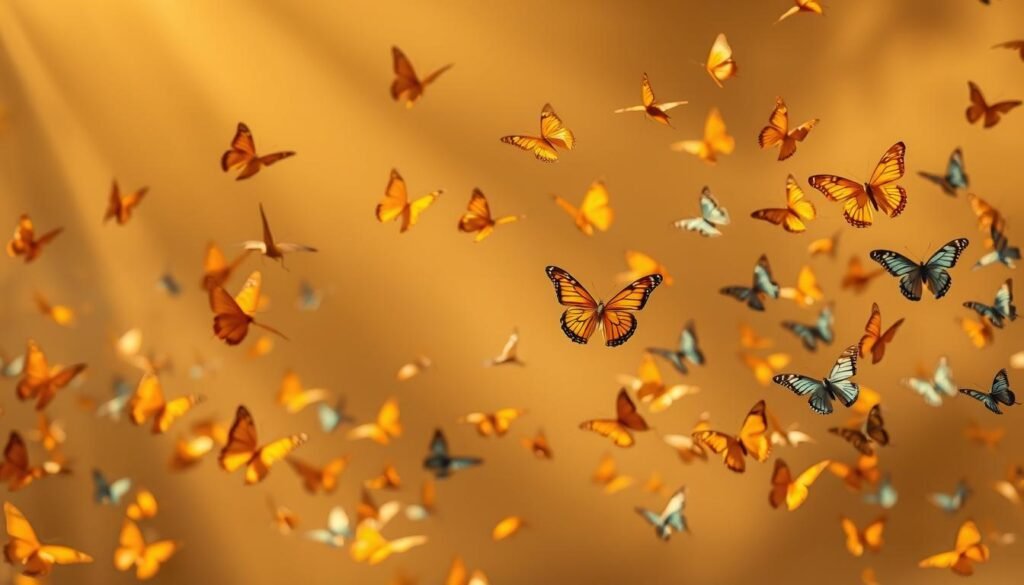
Tips for Creating Dynamic Poses
To draw dynamic poses, pay attention to the butterfly’s body and wing angles. Watch how their wings move and change direction. This creates a sense of motion. Use pictures or watch real butterflies to learn their movement.
- Study the different ways butterflies flap their wings.
- Experiment with various body positions and wing angles.
- Practice drawing different poses to capture the dynamic movement.
Tricks for Making Wings Appear in Motion
To show the wings moving, try a few tricks. First, blur the edges of the wings a bit to suggest movement. Second, use soft, flowing lines for the wings to hint at motion. Lastly, think about the background to make the movement even clearer.
With these tips, you can make stunning drawings of butterflies in flight. You’ll capture their beauty and movement perfectly.
Artistic Styles for Butterfly Drawings
The art of drawing butterflies offers a wide range of styles, from realistic to abstract. This variety lets artists show their creativity in many ways. Whether you like detailed realism or prefer abstract styles, there’s plenty of inspiration in butterfly drawings.
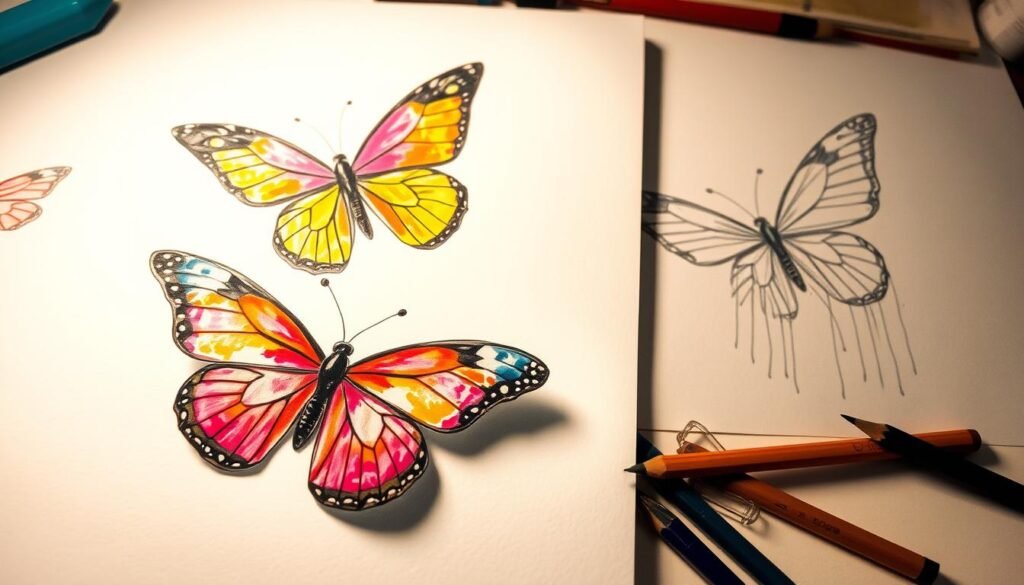
Realism vs. Abstract Interpretations
Artists often choose between realism and abstract styles when drawing butterflies. Realistic drawings aim to accurately show a butterfly’s details, like wing patterns and body texture. Abstract interpretations let artists explore new ways to show a butterfly’s beauty without strict realism.
For more butterfly drawing ideas, many resources can inspire both realistic and abstract styles.
Incorporating Patterns and Textures
Adding patterns and textures to your butterfly drawings can make them more interesting. Patterns can come from nature, like butterfly wing designs, or be abstract. Textures can range from a butterfly’s smooth wings to the roughness of natural settings.
- Try different materials and techniques for unique textures and patterns.
- Look at nature for real patterns and textures to inspire your art.
- Mix realistic details with abstract elements for striking butterfly drawings.
Enhancing Your Butterfly Drawing Skills
To draw beautiful butterflies, you need to practice, study, and join the art community. Being dedicated and open to learning from others is key. This way, you can improve your skills.
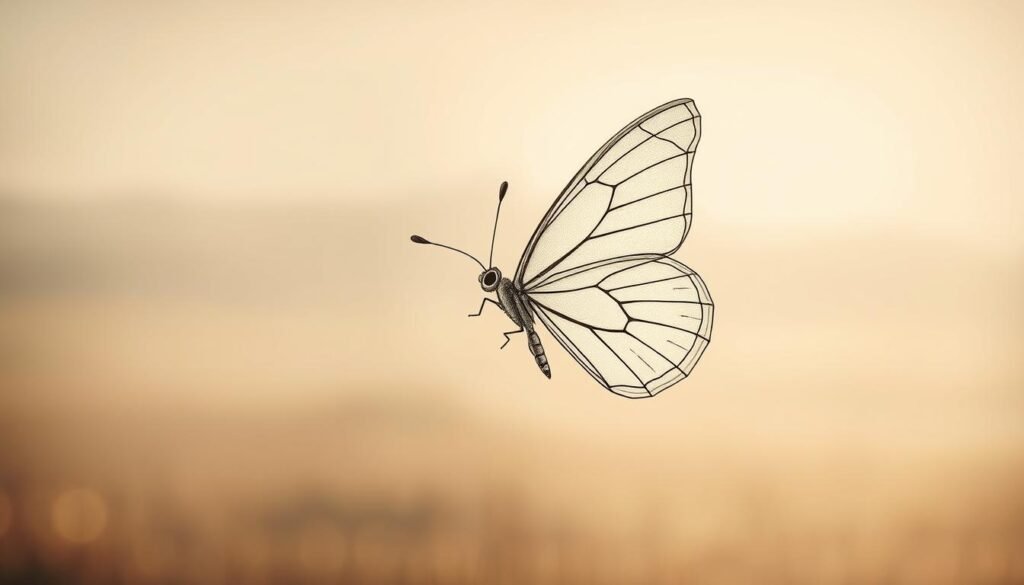
Practicing with Reference Images
Using reference images is a great way to get better at drawing butterflies. These images show the details and colors of different butterflies. You can find them online or take your own photos.
Look closely at the butterfly’s wings and body in the reference images. Study the patterns and structures to draw more realistic butterflies.
Joining Art Communities for Feedback
Joining art communities is another good way to improve your skills. These communities let you share your work and get constructive feedback from other artists.
For more tips and inspiration, check out this blog post on drawing beautiful butterflies. Learning from other artists can really help you grow.
By practicing with reference images and getting feedback from art communities, you can make your butterfly drawings even better. You’ll create beautiful, realistic artwork.
Showcasing Your Finished Butterfly Art
Now that you’ve finished your butterfly drawing, it’s time to show it off. You can add vibrant colors with colored pencils, markers, or watercolors. This makes your butterfly drawing truly unique.
Display Ideas for Your Artwork
Think about framing your butterfly art or displaying it on a canvas. You can also make custom prints or home decor with your artwork online. For more ideas, check out the step-by-step guide on how to draw a butterfly that helped you create your masterpiece.
Sharing on Social Media and Art Platforms
Sharing your art on social media and art platforms can connect you with others. You might get recognized for your work and get feedback from the art community. By showing off your butterfly art, you’re not just sharing your creativity. You’re also inspiring others to explore their artistic side.


